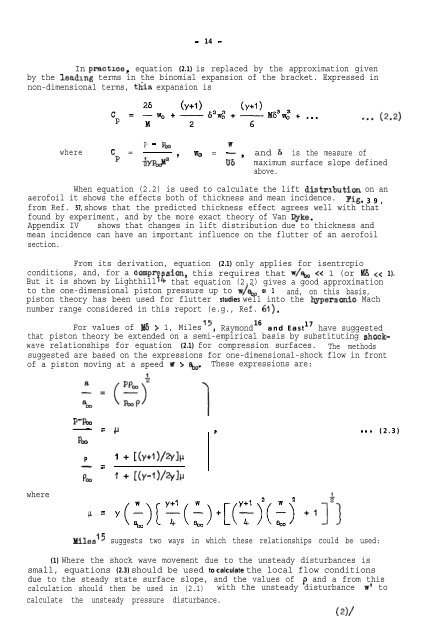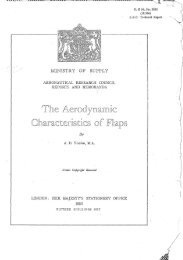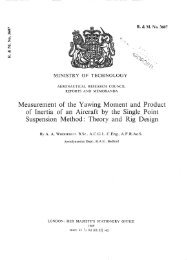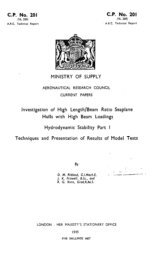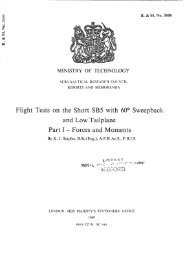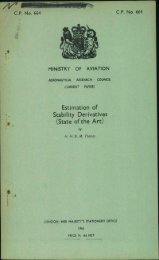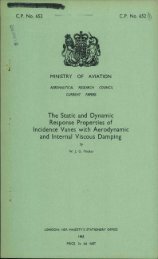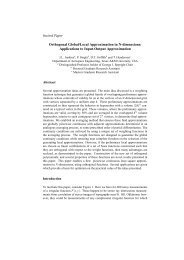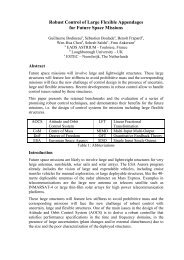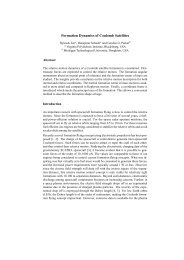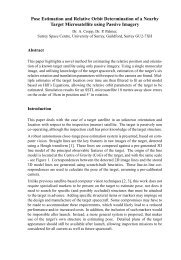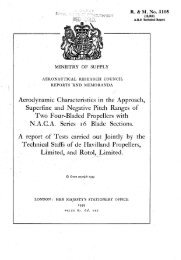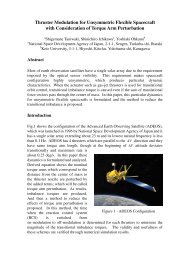A Survey of Unsteady Hypersonic Flow Problems
A Survey of Unsteady Hypersonic Flow Problems
A Survey of Unsteady Hypersonic Flow Problems
You also want an ePaper? Increase the reach of your titles
YUMPU automatically turns print PDFs into web optimized ePapers that Google loves.
- 14 -<br />
In practice, equation (2.1) is replaced by the approximation given<br />
by the leating terms in the binomial expansion <strong>of</strong> the bracket. Expressed in<br />
non-dimensional terms, this expansion is<br />
where c- =<br />
P - pm<br />
SYPe#dS<br />
w<br />
2 -iv0 = -, and 6 is the measure <strong>of</strong><br />
U6 maximum surface slope defined<br />
above.<br />
When equation (2.2) is used to calculate the lift distribution on an<br />
aer<strong>of</strong>oil it shows the effects both <strong>of</strong> thickness and mean incidence. Fig. 39,<br />
from Ref. 57, shows that the predicted thickness effect agrees well with that<br />
found by experiment, and by the more exact theory <strong>of</strong> Van Byke.<br />
Appendix IV shows that changes in lift distribution due to thickness and<br />
mean incidence can have an important influence on the flutter <strong>of</strong> an aer<strong>of</strong>oil<br />
section.<br />
From its derivation, equation (2.1) only applies for isentrcpio<br />
conditions, and, for a compr $fl sion, this requires that W/G CC 1 (or M6 1, Miles'5, Raymond<br />
that<br />
wave<br />
16 and East 17 have suggested<br />
piston theory be extended on a semi-empirical basis by substituting shockrelationships<br />
for equation (2.1) for compression surfaces. The methods<br />
suggested are based on the expressions for one-dimensional-shock flow in front<br />
<strong>of</strong> a piston moving at a speed w > G. These expressions are:<br />
1<br />
where<br />
P-RX?<br />
- = p ,<br />
PC.2<br />
P<br />
-=<br />
PO3<br />
1 + [(Y+~wYlcI<br />
1 + r(Y-fwYlP<br />
p = y(,)[~(,)+[(~y(,.j +I]&]<br />
. . . (2.3)<br />
Milesi suggests two ways in which these relationships could be used:<br />
(1) Where the shock wave movement due to the unsteady disturbances is<br />
small, equations (2.3) should be used to calculate the local flow conditions<br />
due to the steady state surface slope, and the values <strong>of</strong> p and a from this<br />
calculation should then be used in (2.1) with the unsteady disturbance w' to<br />
calculate the unsteady pressure disturbance.<br />
(PI/


